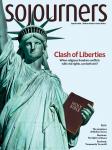IN JUNE, THE U.S. SUPREME COURT ruled in favor of a Lutheran church in Missouri seeking state funding to replace the gravel yard of its playground with a softer surface made of recycled tires. But was it a victory for religious freedom or a violation of the principles separating church and state? Sojourners associate editor Betsy Shirley interviewed Charles C. Haynes, founding director of the Religious Freedom Center of the Newseum Institute, to help sort it all out.
Sojourners: Let’s start with the basics: Where does the idea of “separation of church and state” come from?
Charles Haynes: The Establishment Clause—or, more accurately, the “no establishment clause”—is the part of the First Amendment that separates church from state, preventing the entanglement of religion and government that has been the source of repression and conflict for much of human history. But it also protects the right of religious groups and individuals to participate fully in the public square of America.
What about the right to worship freely? The Free Exercise Clause guarantees liberty of conscience for people of all faiths and none. It protects our freedom to practice our religion openly and freely without governmental interference. The two religious-liberty clauses protect one freedom: liberty of conscience for all.
What do these clauses have to do with Trinity Lutheran’s playground? Trinity Lutheran Church v. Comer is the latest in a long line of cases concerning government funding and religious institutions. The decision in Trinity builds on a trend in recent decades toward a more “accommodationist” reading of the Establishment Clause, lowering the “wall of separation” to allow more accommodation of religion by government.
What do you mean by “more accommodation”? Even though the Missouri state constitution prohibits funding of religion, the high court found the playground improvement funds were for the health and safety of children and did not constitute direct state aid to religion. Religious institutions are, therefore, eligible to apply for those funds on the same basis as secular institutions.
Why was this controversial? The majority of the Supreme Court—and the majority of Americans—agree that direct funding of religion by government is a violation of conscience prohibited by the Establishment Clause. Where we disagree is the question of where to draw the line on what constitutes funding or support for religion by government. As the Trinity case confirms, the majority of the current court sees no problem with equal treatment for religious groups applying for government funding programs available to secular groups. To exclude religious groups, the majority argues, is religious discrimination in violation of the Free Exercise Clause.
But if the government gives money to a church, doesn’t that violate the Establishment Clause? The argument that this funding would be used to support the religious mission of the church carried no weight with the majority. Establishment Clause concerns were conspicuously absent from the majority opinion. As a result, we can expect to see religious groups applying for and receiving government funding for a wide range of purposes.
What new questions about religious freedom does the Trinity decision raise? Will the decision be interpreted as limited to programs like “playground resurfacing,” as four justices suggest in a footnote to the majority opinion? Or will the decision open the door to religious institutions receiving government funding for a wide range of purposes? That remains to be seen.
What do you think? In my view, this decision will likely result in a lower wall of separation between church and state.

Got something to say about what you're reading? We value your feedback!

